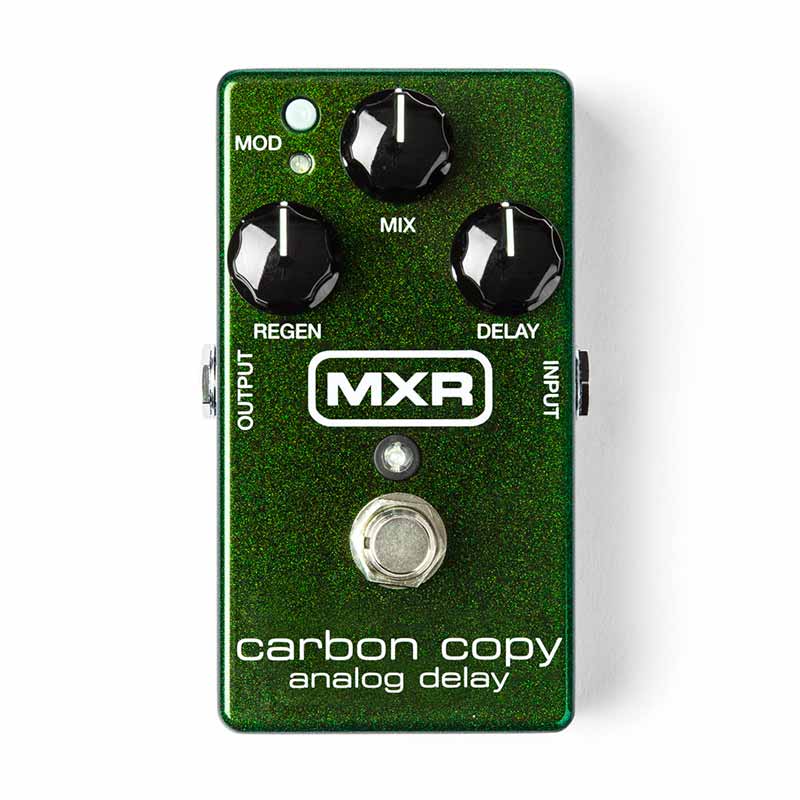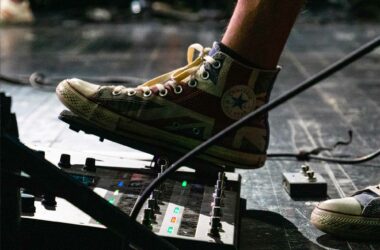Within the infinite universe of guitar effects, delay pedals emerge like time magicians, capturing notes and letting them resonate in space. Delays create soundscapes by adding a temporal dimension to your playing. In this article, we delve into the captivating world of delay pedals, exploring how they work, the different types available, how to use them, how to integrate them into a pedalboard and a selection of iconic models that have marked the history of music.
What is a delay pedal?
Before diving into the details, let’s understand the basics. A delay pedal is an electronic device that reproduces a sound signal with a slight time shift, creating repetitions of the notes played. In other words, it offers an extended version of your sound by reproducing echoes. This feature can vary in intensity, from a slight slapback to prolonged repetitions.
A little history
The history of delay pedals goes back to the early days of sound effects exploration in music. In the 1950s, the “Maestro Echoplex ” tape echo pedal marked the beginning of this sonic revolution. Musicians quickly adopted this effect, creating unprecedented sound textures. In the 1960s, the appearance of the “Roland RE-201 Space Echo” pedal brought a unique spatial dimension to rehearsals, becoming an icon of the psychedelic era. The 1970s saw the advent of the “Electro-Harmonix Memory Man” and “MXR Carbon Copy” pedals, introducing analog with its warm, organic repeats. The rise of digital in the 1980s was marked by the “Boss DD-2” paving the way for greater versatility. The following decade saw the rise of digital processors with models such as the “Line 6 DL4.”

The lexical field of delay
To navigate the world of delays, it is essential to understand the often complex lexicon associated with these pedals:
- Feedback” represents the number of repetitions generated by the pedal,
- Tap tempo” allows the musician to synchronize repetitions with the tempo of the music by rhythmically tapping a dedicated button,
- The “time” parameter controls the time between repetitions,
- The “repeat” determines the number of successive signal repetitions,
- Modulation” adds a sense of movement to the repetitions,
- The “pre-delay” controls the amount of time before repeats begin, adding a subtle dimension to the delay’s spatiality,
- The “multi-tap delay” on some pedals allows you to define multiple repetition points, offering a variety of complex rhythmic patterns,
- The “Hold” function can freeze a repeat indefinitely, creating a real-time sound loop that the musician can superimpose with new notes,
- The “reverse delay” produces repetitions that develop in a retrograde manner, creating an inverted sound effect,
- Some delays offer a “filter ” function to adjust the tonality of repeats, from a brighter to a darker sound.
The different types of delay
Delay pedals come in several types, each with its own specific features:
- Analog Delay: Renowned for its warm, organic character, analog delay uses electronic components to create repeats. These repeats can be less sharp than those of digital delays, adding a vintage, natural touch to the sound.
- Digital Delay : Using digital processors, the digital delay offers precise reproduction of the original signal with great clarity. It is appreciated for its versatility and ability to produce short and long delays with exceptional fidelity.
- Tape Delay : Inspired by the old tape recorders, the tape delay recreates the warm, slightly modulated sound of the era. It adds a subtle coloration to the sound, evoking the nostalgia of vintage recordings.
- Bucket Brigade Device (BBD) Delay: Based on a chain of analog components called the “Bucket Brigade”, this type of delay offers a unique sound with a slight loss of quality over repetitions, creating a particular effect appreciated in certain situations.
Creative delay pedals: to infinity and beyond!
Some delay pedals not only faithfully reproduce the original sound with a simple time shift, they also open the door to a multitude of creative effects. Modulation (chorus, flanger, phaser, tremolo, vibrato…), often integrated into delay pedals, adds a gentle oscillation to repeats, creating a subtle effect of movement. Modern pedals offer advanced features such as the ability to create atmospheric ambiences with integrated reverbs, transforming simple repetition into an immersive experience. Some pedals also let you adjust the depth and speed of modulation, giving guitarists total control over the tonal color of their rehearsals. Creative use of these effects can create unique soundscapes and add an extra dimension to your playing.

How to use a delay pedal properly
Incorporating a delay pedal into your setup can significantly transform your sound. Here are a few tips on how to make the most of this temporal nugget:
- Finding the right settings : Most delay pedals offer controls such as delay time, repeat level and sometimes modulation options. Experiment with these settings to find the sound that suits your style.
- Synchronize with tempo: Some delay pedals offer a tempo-sync function (a tap tempo), allowing you to set repeats to the rhythm of the song. This can be particularly useful in live performance.
- Use it sparingly: Although delay effects are fascinating, using them excessively can make the sound quite confusing. Use them sparingly to accentuate specific passages or create unique ambiences.
Where to place the delay pedal in your pedalboard?
The position of a delay pedal in the effects chain is crucial. In general, it is placed after the gain pedals (overdrive, distortion) to repeat the altered signal. In fact, it’s often recommended to place delay pedals at the end of the chain (possibly before your reverbs). However, experimenting with placement can lead to interesting results. Some guitarists even prefer to have two delay pedals for varied sound textures.
Some emblematic models:

Boss DD-7 Digital Delay
The Boss DD-7 occupies a prime position among digital delay pedals. Known for its exceptional versatility, this model offers a variety of delay modes, including the famous “Hold” mode for creating sound loops in real time. With its compact size and advanced features, the DD-7 is a reliable ally for guitarists seeking sonic variety and creativity.
Strymon Timeline Delay
The Strymon Timeline is the epitome of sound quality in the world of delay pedals. Appreciated by the most demanding guitarists, this digital nugget offers an extensive palette of delay types, each offering exceptional sonic fidelity. From reverse delay to tape echo, the Timeline lets you explore an impressive range of temporal textures, making it a preferred choice for artists seeking expressiveness and precision.


TC Electronic Flashback Mini Delay
Compact yet powerful, the TC Electronic Flashback Mini is a digital pedal that sacrifices nothing in terms of sound quality. Offering a variety of delays, from classic to modern, this little nugget slips easily onto any pedalboard. Its ease of use and practical dimensions make it an ideal choice for guitarists looking for an efficient solution without compromising on quality.
Electro-Harmonix Memory Man Deluxe Delay
Dive into the vintage charm of analog with the Electro-Harmonix Memory Man Deluxe. This pedal offers warm repeats and mesmerizing modulation, seducing fans of classic sound. Packed with extensive features, including a chorus/vibrato selector and modulation controls, Memory Man Deluxe transports you back to the era of analog recording while offering modern flexibility. A must-have for vintage sound enthusiasts.


MXR Carbon Copy Delay
The MXR Carbon Copy is a benchmark among analog delay pedals. Famous for its rich, organic tone, it delivers smooth, natural repeats. With its simple, intuitive controls, it will appeal to guitarists looking for a warm, user-friendly delay.
EarthQuaker Devices Avalanche Run Delay
The EarthQuaker Devices Avalanche Run is a nugget that fuses delay and reverb to create expansive soundscapes. With intuitive controls, it lets you explore ambiances ranging from the subtle to the spectacular. Ideal for musicians looking to push back the boundaries of their creativity.


JHS Pedals Panther Cub V2 Delay
For fans of vintage sound, the JHS Pedals Panther Cub V2 offers a delay experience inspired by classic tape units. With its warm character and compact design, this pedal offers true sonic nostalgia without the hassle of vintage equipment.
Walrus Audio Mako Series D1 Delay
The Walrus Audio Mako Series D1 is a versatile delay pedal that combines digital precision with modern functionality. Offering a variety of delay modes and modulation possibilities, it’s aimed at guitarists looking for a complete solution for sculpting their sound.


Eventide TimeFactor delay
The Eventide TimeFactor is the epitome of delay pedal excellence. With a reputation for studio sound quality, this digital pedal offers a multitude of delay options, from vintage to futuristic. It’s a preferred choice for demanding musicians who want to push the boundaries of sonic creativity.
What delay pedals do you use? Don’t hesitate to share your experience and preferences with us in the comments 😉










